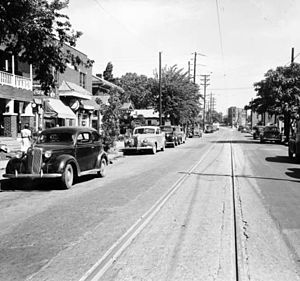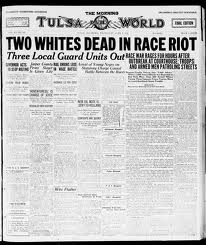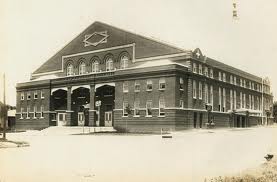Calm Before the Storm
 May 31, 1921, was Memorial Day – or Decoration Day as it was often called in that era. A parade marched through the streets of downtown Tulsa, Oklahoma. North of the city, in the all-black, segregated community of Greenwood, citizens went about their business as usual. The Booker T. Washington high school students were preparing for their prom to take place that evening.
May 31, 1921, was Memorial Day – or Decoration Day as it was often called in that era. A parade marched through the streets of downtown Tulsa, Oklahoma. North of the city, in the all-black, segregated community of Greenwood, citizens went about their business as usual. The Booker T. Washington high school students were preparing for their prom to take place that evening.
In downtown Tulsa, a nineteen-year-old shoeshine boy named Dick Rowland was at work with his shoeshine business. Because of segregated restrooms in Tulsa, no facility existed in the shoeshine parlor where he worked, forcing Rowland to use the washroom for blacks located on the top floor of the Drexel Building.
No One Will Ever Know
That day, as he had done many times before, Dick stepped into the elevator of the Drexel Building. The elevator operator, a seventeen-year-old white girl named Sarah Page, manned the elevator. No one knows for sure what happened in that elevator. Perhaps Dick tripped and fell against her. No one will ever know. Sarah let out a scream. Dick, knowing the worst accusation that could ever come against a black man was that of accosting a white woman, fled in fear.
An employee from the nearby Renberg’s store came running, saw Dick fleeing and called police. The next day, Dick Rowland was found by the police in the Greenwood area and arrested. Next followed a series of events that continued to escalate until it was totally out of control.
Inflammatory Headlines
 Tulsans of that day received their news through one or the other city newspaper – the Tulsa World, or the Tulsa Tribune. The former was old and established. The latter, only a few years old had been started by a man from Wisconsin named Richard Lloyd Jones. It was Jones’s intention to be the cutting-edge news leader, unafraid to take on controversial issues. Already, the newspaper had cited vigilante acts in other parts of the country and pointed out how effective such actions were in maintaining law and order. At the time, Tulsa’s crime problem provided the perfect arena for the Tribune to make a name for itself.
Tulsans of that day received their news through one or the other city newspaper – the Tulsa World, or the Tulsa Tribune. The former was old and established. The latter, only a few years old had been started by a man from Wisconsin named Richard Lloyd Jones. It was Jones’s intention to be the cutting-edge news leader, unafraid to take on controversial issues. Already, the newspaper had cited vigilante acts in other parts of the country and pointed out how effective such actions were in maintaining law and order. At the time, Tulsa’s crime problem provided the perfect arena for the Tribune to make a name for itself.
Since the Tribune was the evening paper, they had the advantage of creating inflammatory headlines the night of May 31 regarding the Rowland incident. That copy was never to be found in later years. (And of course for many years no one wanted to find it.) Bound volumes no longer exist (the Tribune closed its doors in the 1992). But looking at the microfilm version – which does exist – the front-page article and most of the editorial page for that issue had at some point in the past been deliberately torn out.
Something was in those headlines that someone wanted to hide. Some have said the word lynch or lynching might have been in those headlines. At any rate, Dick Rowland was being held in a jail cell in the top floor of the courthouse (photo on the left). A group of armed blacks (many were WWI veterans) gathered in the street below in an attempt to ward off a possible lynching.
Whites also gathered and soon a gun went off and the conflict was suddenly inflamed! In this initial chaos, twelve people were killed.
The blacks fled northward, gathering more armed men to defend their community. Their efforts were valiant, but they had no idea what they were up against.
In my next blog post, the horrors of the riot are revealed. Later, I’ll share how a fiction novel can be shaped and formed from such an abundance of research information.
~*~*~*~*~*~*~*~*~*~*~*~*~
 Are you one of those budding novelists who makes a great start but you can’t seem to finish? Then this is for you! Be A Novelist, Six-Month, Finish-My-Novel Challenge! Six full months of guidance and instruction. Guaranteed to light a fire under your novel-writing attempts and to launch you into a pattern of consistent writing! Check it out here!
Are you one of those budding novelists who makes a great start but you can’t seem to finish? Then this is for you! Be A Novelist, Six-Month, Finish-My-Novel Challenge! Six full months of guidance and instruction. Guaranteed to light a fire under your novel-writing attempts and to launch you into a pattern of consistent writing! Check it out here!
~*~*~*~*~*~*~*~*~*~*~*~*~

